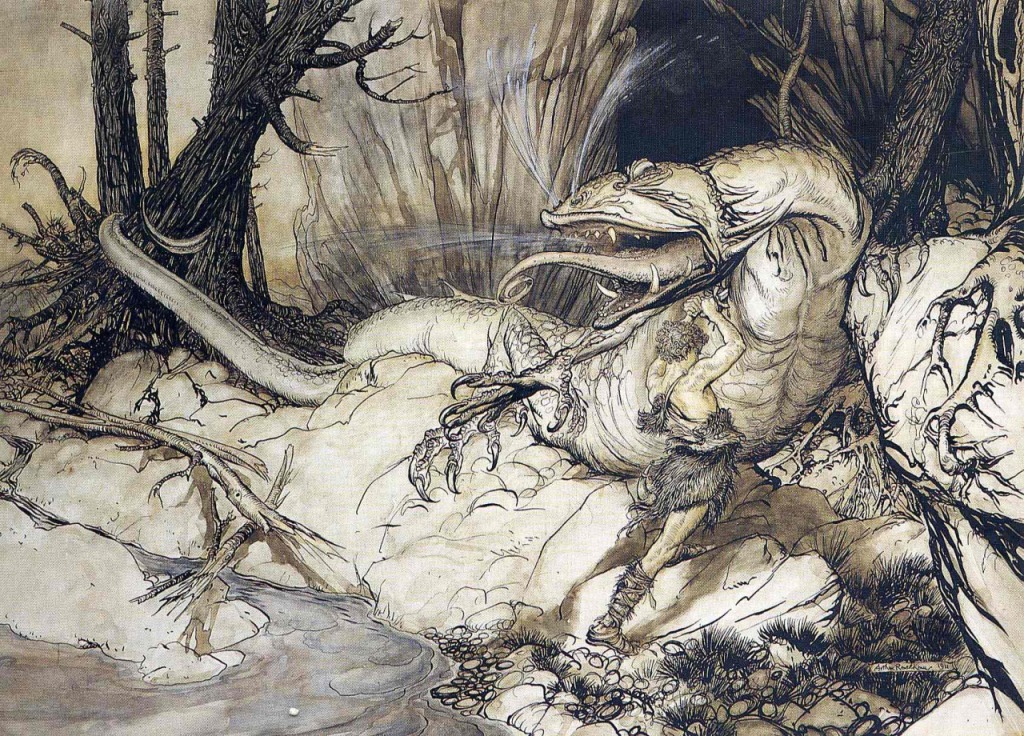Curses are formidable entities that hold powerful consequences against those who are unfortunate enough of being one of its subjects. In Old Norse literature, Andvari’s curse shapes the story of Sigurd, as it does in J.R.R. Tolkien’s own rendition in The Legend of Sigurd and Gudrún, but this tradition also folded itself into Tolkien’s Legendarium before and while he was writing the Lays in the early 1930s. Why curses hold so much sway is that they are not just to say something, but they are speech-acts; J.L. Austin, in How to Do Things with Words, explains that by the act of saying something, one is doing something, specifically the one cursing having the power to produce certain intended outcomes. The tradition of using a curse, and its function as being a speech-act, is what dictates the fate of its object – in Norse literature with Sigurd and in Tolkien’s Legendarium in the curse of Mîm – and the consequences thereof.
Not only is the curse a powerful force to be reckoned with, but words themselves are instruments that can bring about intended or unintended consequences simply by uttering them. Austin discusses speech-act theory as certain words having a performative capability, stating: “the uttering of the sentence is, or is a part of, the doing of an action,” and not “just” saying something (5). These utterances must also be performed by certain persons in certain circumstances to have their anticipated impact, and specifically, a curse must also hold to certain conventions for it to do something. Austin establishes five classes of verbs, each with their own particular conditions where they are used: Verdictives, Exercitives, Commissives, Behabitives, and Expositives. In particular, cursing falls under the Behabitives, which “include the notion of reaction to other people’s behaviour and fortunes and of attitudes and expressions of attitudes to someone else’s past conduct or imminent conduct” (160). For this performative, there is an agent (the curser) and an object (the one being cursed), in which the agent reacts to the behavior of the object – and probably more specifically the connection the behavior has to the agent – and performs a curse on the one they wish, which then has its premeditated effect. Speaking a curse is not just to say some words, but by speaking it aloud for one to hear, there is a force behind the words.
Austin also characterizes the performing of speech-acts as either illocutionary or perlocutionary. Illocutionary is the “performance of an act in saying something as opposed to performance of an act of saying something,” which he calls “the doctrine of ‘illocutionary forces’” (99-100, italics original). In saying something, there is an effect on the hearer, as opposed to only saying something aloud, which is the act of saying something, as in a statement of fact. The result of an illocutionary act, though, “[s]aying something will often, or even normally, produce certain consequential effects upon the feelings, thoughts, or actions of the audience, or of the speaker, or of other persons,” which is the perlocutionary act (101). Therefore, there is a difference between the act itself and the consequences of said act. For a curse, the force of the words, “I curse you,” has the effect, if they are understood, of then successfully cursing the object of the curse, and then by saying the curse, there are consequential effects on the audience, which is now the curse playing itself out. Thus, a curse has both an illocutionary and perlocutionary function. The curse coming into fruition therefore acts as the instrument of fate for the one cursed and dictates the consequences thereof. Specifically, in Norse mythology, the tradition of cursed treasure holds the intended effects – or fate – of the keeper of said gold.
This tradition, and Tolkien’s use of it his own mythology, begins in the Codex Regius manuscript where The Poetic Edda dwells, and The Lay of Regin specifically holds the origins of this tradition in Norse mythology. As the tale goes, when Odin, Loki, and Hoenir arrive at Andvara-falls, after Loki kills Otter by striking him with a stone, his father Hreidmar demands a ransom for his son’s death. Loki is charged with securing this ransom; going back to Andvara-falls, he fishes out Andvari and commands him to give up his gold. This leads to Andvari proclaiming his curse:
“‘That gold, which Gust owned,
Will be the death of two brothers,
And cause strife between eight princes;
My treasure will be no use to anyone’” (Poetic Edda 148).
Although the verb “curse” or a structure entailing the phrase, “I curse you,” is not present in Andvari’s speech, the curse, as Anna Engelking says, is “implicitly performed,” which are “utterances whose semantic structure is ‘power, grant that something bad happens to X’ and whose illocutionary force can be called the force of the curse” (223). But by saying, “will be,” it also indicates a promise of the consequences that will come at a later date. Also, the object of the curse is not any one person but the gold itself, and the audience here is Loki, who will later act as the transmitter of the curse when he tells Hreidmar, “for your son no good fortune is ordained; / it will be the death of both of you!” (Poetic Edda 148). This also raises the question of whether it is necessary to pass down the curse orally for it to truly take effect. Regardless, the curse is understood by Loki, thereby Andvari executing a successful illocutionary act, and the perlocutionary act will then lie in the reaction to the curse, which Loki relays. In consequence, the curse begins to take its toll on Hreidmar and his sons. Fáfnir kills his father for the gold, not leaving Regin a single coin, and turns into the shape of a dragon. After Regin has relayed the tale to Sigurd, he eggs Sigurd on to kill Fáfnir.
Curses also have an important narrative function as part of this tradition. In his article, “Prophesy in the Ancient Epic,” Clifford Herschel Moore notes that concerning prophesy in ancient epics like The Odyssey, “the element of suspense, of imaginative anticipation of the catastrophe, is a matter of prime importance” to “stir the imaginations of his audience to anticipate the crisis” (101-102). Although Moore is concerned specifically with how prophesy operates in these epics, the same can be said for a curse. The point is to foreshadow the climax of what will befall the hero and keep the audience in a state of suspense, wondering about how the events will take place. In this way, Andvari’s curse passes on to Loki, who tells it to Hreidmar, leading to the more important scene with Fáfnir and Sigurd, as the curse continues to work in the fate of those who are tied to the treasure.
In The Lay of Fáfnir, after Sigurd delivers the killing blow to the dragon, there is a more ancient “the name and the curse” motif happening in the aftermath. Fáfnir asks for Sigurd’s name, which he at first refuses; however, after being pressed, Sigurd reveals himself. Calvin S. Brown draws the connection between the name and the curse in his article, “Odysseus and Polyphemus: The Name and the Curse,” when at first Odysseus conceals his name from the cyclops, only to share it afterward, Brown says, “the name makes possible the curse” that Polyphemus hurls at Odysseus and “enables the giant to pursue his escaped tormentor and to inflict new perils on him” (201-202). Like Moore’s postulation that prophesy functions to set up major events in the story, Brown says the same works for the curse, which propels the story forward for the anticipatory audience; the curse props up the idea of fate as the prime mover in the plot. This tradition then becomes tied to the story of Sigurd; Brown comments that, “[c]oncealing a name at first and then giving it, usually after achieving victory, is common enough in Indo-European legend,” which of course is what Sigurd does (198).
However, there is no need for Fáfnir to curse Sigurd since Andvari’s curse has already made it so that the treasure would be no use to anyone. Instead, Fáfnir warns Sigurd of the curse by saying, “the resounding gold and the glowing red treasure, / those rings will be your death!’” and when Sigurd does not listen the first time, he even repeats the warning (Poetic Edda 155). Elizabeth A. Sanders notes that “[r]epetition also seems to provide another manner in which prophecies and curses create suspense within the audience, as they are often repeated within the epic,” which emphasizes the importance of “how something will come to pass rather than what” (9, italics original). Therefore, once again, the curse is carried along to all who would hear, the warning itself having an illocutionary force; the perlocutionary act of the curse thus continues and creates the anticipation of what will befall Sigurd.
This culminates in what is left in The Poetic Edda, after the lacuna in the manuscript, in “Fragment of a Poem About Sigurd” where, following Brynhild’s perceived betrayal by Sigurd, she devises a scheme to get Gunnar and Hogni to kill the oath-breaker. They convince their brother Guthorm to do it instead, and as it says, “Dead was Sigurd on the south side of the Rhine” (Poetic Edda 169). The fate of the curse comes to fruition for Sigurd because, firstly, he received the warning of the curse with his own ears, satisfying the illocutionary act, and secondly, he was the natural next victim of the curse since he was the keeper of the gold and, therefore, subject to the cursed object and the perlocutionary consequences thereof.
Works Cited
Austin, J.L. How to Do Things with Words. edited by J.O. Urmson and Marina Sbisà, Harvard University Press, 1975.
Brown, Calvin S. “Odysseus and Polyphemus: The Name and the Curse.” Comparative Literature, vol. 18, no. 3, 1966, pp. 193–202. JSTOR, www.jstor.org/stable/1770048.
Engelking, Anna. The Curse: On Folk Magic of the Word. Translated by Anna Gutowska, Institute of Slavic Studies, Polish Academy of Sciences, 2017, https://ispan.waw.pl/ireteslaw/handle/20.500.12528/81.
Moore, Clifford Herschel. “Prophecy in the Ancient Epic.” Harvard Studies in Classical Philology, vol. 32, 1921, pp. 99–175. JSTOR, www.jstor.org/stable/310716.
The Poetic Edda, Translated by Carolyne Larrington, Oxford University Press, Revised Edition, 2014.
Sanders, Elizabeth A. The Narrative Function of Prophecy and Curse in Medieval British Isle Epics. 2011. University of Arkansas, Ann Arbor, Master’s thesis, ProQuest, https://ezproxy.shsu.edu/login?url=https://www-proquest-com.ezproxy.shsu.edu/dissertations-theses/narrative-function-prophecy-curse-medieval/docview/869732191/se-2?accountid=7065.




